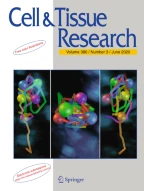Abstract
Receptor cells of the olfactory epithelium (OE) and vomeronasal organ (VNO) project axons to glomeruli in the main olfactory bulb (MOB) and accessory olfactory bulb (AOB), respectively and undergo continuous turnover throughout life. Alpha1–2 fucose (α1–2Fuc) glycan mediates neurite outgrowth and synaptic plasticity and plays important roles in the formation of the olfactory system during development. We previously confirmed the localization of α1–2Fuc glycan in the olfactory system of 3- to 4-month-old mice but whether such localization persists throughout life remains unknown. Here, the MOB, AOB, OE and VNO of 1-, 3- and 8-month-old mice were histochemically examined using Ulex europaeus agglutinin-I (UEA-I) that specifically binds to α1–2Fuc glycan. Binding sites for UEA-I in the MOB were similar among all age groups but the ratio of UEA-I-positive glomeruli significantly decreased with aging. The frequency of UEA-I-positive receptor cells in the OE of the two older groups was also significantly lower than that of 1-month-old mice. On the other hand, UEA-I binding in the AOB and VNO did not significantly differ among all three groups. These findings suggest that the primary pathway of the main olfactory system requires the role of α1–2Fuc glycan in young mice rather than old mice, while the vomeronasal pathway equally requires this glycan in both young and old mice.
Similar content being viewed by others
References
Barrios AW, Núñez G, Sánchez Quinteiro P, Salazar I (2014) Anatomy, histochemistry, and immunohistochemistry of the olfactory subsystems in mice. Front Neuroanat 8:63
Ducray A, Propper A, Kastner A (1999) Detection of alpha-L fucose containing carbohydrates in mouse immature olfactory neurons. Neurosci Lett 274:17–20
Graziadei PPC, Monti Graziadei GA (1979) Neurogenesis and neuron regeneration in the olfactory system of mammals. I. Morphological aspects of differentiation and structural organization of the olfactory sensory neurons. J Neurocytol 8:1–18
Kalovidouris SA, Gama CI, Lee LW, Hsieh-Wilson LC (2005) A role for fucose α(1–2) galactose carbohydrates in neuronal growth. J Am Chem Soc 127:1340–1341
Kondo K, Suzukawa K, Sakamoto T, Watanabe K, Kanaya K, Ushio M, Yamaguchi T, Nibu K, Kaga K, Yamasoba T (2010) Age-related changes in cell dynamics of the postnatal mouse olfactory neuroepithelium: cell proliferation, neuronal differentiation, and cell death. J Comp Neurol 518:1962–1975
Kondoh D, Tateno H, Hirabayashi J, Yasumoto Y, Nakao R, Oishi K (2014) Molecular clock regulates daily α1–2-fucosylation of the neural cell adhesion molecule (NCAM) within mouse secondary olfactory neurons. J Biol Chem 289:36158–36165
Kondoh D, Kamikawa A, Sasaki M, Kitamura N (2017) Localization of α1–2 fucose glycan in the mouse olfactory pathway. Cells Tissues Organs 203:20–28
Krug M, Jork R, Reymann K, Wagner M, Matthies H (1991) The amnesic substance 2-deoxy-D-galactose suppresses the maintenance of hippocampal LTP. Brain Res 540:237–242
Krug M, Wagner M, Staak S, Smalla KH (1994) Fucose and fucose-containing sugar epitopes enhance hippocampal long-term potentiation in the freely moving rat. Brain Res 643:130–135
Lipscomb BW, Treloar HB, Greer CA (2002) Novel microglomerular structures in the olfactory bulb of mice. J Neurosci 22:766–774
Lipscomb BW, Treloar HB, Klenoff J, Greer CA (2003) Cell surface carbohydrates and glomerular targeting of olfactory sensory neuron axons in the mouse. J Comp Neurol 467:22–31
Lorenzini CG, Baldi E, Bucherelli C, Sacchetti B, Tassoni G (1997) 2-deoxy-D-galactose effects on passive avoidance memorization in the rat. Neurobiol Learn Mem 68:317–324
Lundh B, Brockstedt U, Kristensson K (1989) Lectin-binding pattern of neuroepithelial and respiratory epithelial cells in the mouse nasal cavity. Histochem J 21:33–43
Matthies H, Staak S, Krug M (1996) Fucose and fucosyllactose enhance in vitro hippocampal long-term potentiation. Brain Res 725:276–280
Murrey HE, Gama CI, Kalovidouris SA, Luo WI, Driggers EM, Porton B, Hsieh-Wilson LC (2006) Protein fucosylation regulates synapsin Ia/Ib expression and neuronal morphology in primary hippocampal neurons. Proc Natl Acad Sci U S A 103:21–26
Murrey HE, Ficarro SB, Krishnamurthy C, Domino SE, Peters EC, Hsieh-Wilson LC (2009) Identification of the plasticity-relevant fucose-α(1–2)-galactose proteome from the mouse olfactory bulb. Biochemistry 48:7261–7270
Pohle W, Acosta L, Rüthrich H, Krug M, Matthies H (1987) Incorporation of [3H]fucose in rat hippocampal structures after conditioning by perforant path stimulation and after LTP-producing tetanization. Brain Res 410:245–256
Salazar I, Sánchez Quinteiro P (2003) Differential development of binding sites for four lectins in the vomeronasal system of juvenile mouse: from the sensory transduction site to the first relay stage. Brain Res 979:15–26
Salazar I, Sánchez Quinteiro P, Lombardero M, Cifuentes JM (2001) Histochemical identification of carbohydrate moieties in the accessory olfactory bulb of the mouse using a panel of lectins. Chem Senses 26:645–652
Weiler E, Farbman AI (1997) Proliferation in the rat olfactory epithelium: age-dependent changes. J Neurosci 17:3610–3622
Acknowledgements
We thank the staff of the Laboratory Animal Center, Obihiro University of Agriculture and Veterinary Medicine, for maintaining the animals.
Funding
Grant-in-Aid for Young Scientists (B) KAKENHI (15K20841) to D.K. from the Ministry of Education, Culture, Sports, Science and Technology (MEXT) of Japan.
Author information
Authors and Affiliations
Corresponding author
Ethics declarations
Conflict of interest
The authors declare that they have no conflict of interest.
Ethical approval
All procedures performed in studies involving animals were in accordance with the Regulations on the Management and Operation of Animal Experiments and the Animal Care and Use Committee of Obihiro University of Agriculture and Veterinary Medicine approved the experimental protocol (Approval numbers 27-20 and 28-36).
Rights and permissions
About this article
Cite this article
Kondoh, D., Sasaki, M. & Kitamura, N. Age-dependent decrease in glomeruli and receptor cells containing α1–2 fucose glycan in the mouse main olfactory system but not in the vomeronasal system. Cell Tissue Res 373, 361–366 (2018). https://doi.org/10.1007/s00441-018-2819-9
Received:
Accepted:
Published:
Issue Date:
DOI: https://doi.org/10.1007/s00441-018-2819-9
